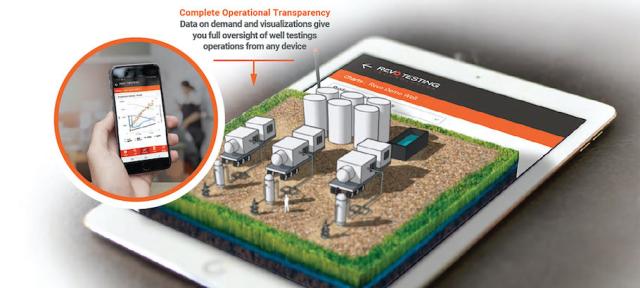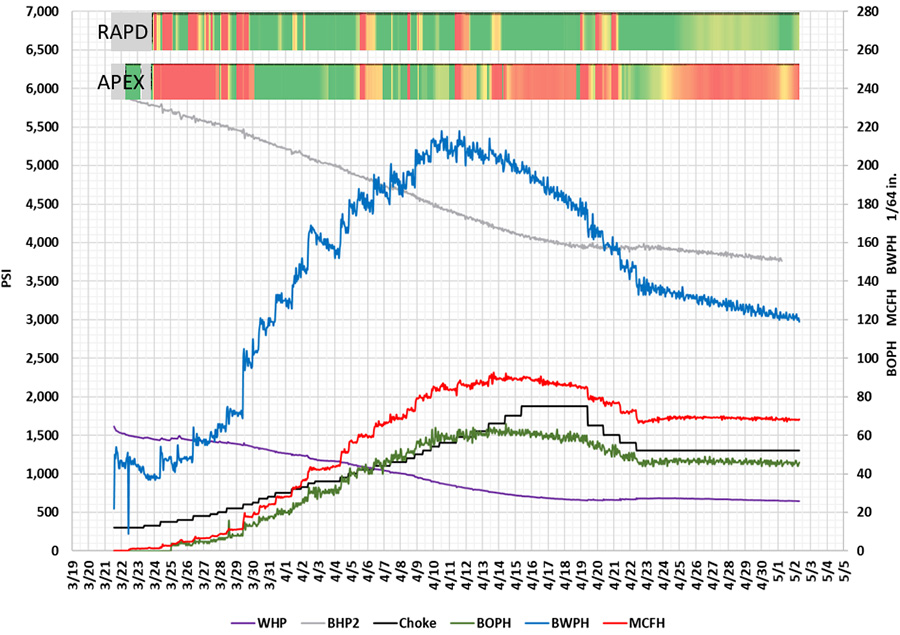
(Source: Revo Testing Technologies)
Presented by:
Editor's note: This article originally appeared in the May issue of E&P Plus.
Subscribe to the new E&P digital newsletter here.
The push for a more digital oilfield has led to the creation of numerous software tools to take advantage of newly available real-time well data. The waterfall of data that is now being captured has resulted in the need for productivity solutions to help engineering teams focus on the conclusions provided by the data, not data management itself. Engineers now have a variety of options to help them visualize and analyze data during just about every point of a well’s life. However, one segment has been left behind on the path to a digital oilfield–unconventional well flowback and well testing.
Early-time flowback data provides one of the first glimpses of valuable information to manage a well’s drawdown and evaluate reservoir responses and well performance. Yet many in the industry are not leveraging this data to optimize their completions and well production. One of the primary reasons being the poor data quality traditionally being captured during this period, often making analysis difficult or even impossible. Additionally, the fact that this data is still typically recorded manually and sent in an email or text message makes using and managing the data a time-intensive process.
Instead, simple production targets, drawdown limits or even rules of thumb are often used to manage the well startup. Most engineers don’t have the time or expertise to spend their days compiling and analyzing flowback data to optimize their choke and drawdown management.
Revo Testing Technologies has recently released the Revo iQ software package to solve these problems and give operators the opportunity to effectively manage this crucial period of a well’s life. The system helps modernize flowback operations and give engineers the tools they need to tailor a drawdown strategy to every well, without spending all day sorting through flowback reports.
Flowback digitalization
For many operators unconventional flowback data management has fallen behind almost every other part of a well’s life. Text message chains, periodic emails and difficult-to-use Excel files are all part of the archaic processes that most operators still utilize to manage their flowback data. Add to that data errors or missed reports from flowback hands in the field and it is easy to see why it has been simpler to just use a standard basic strategy on every well.
With Revo iQ, data is streamed live from the field to a PC or mobile device so that well result updates are instantly available. Data can be captured by Revo’s automated flow testing hardware, existing SCADA equipment, or by service provider in the field as soon as they take their measurements. Well information is all stored in the cloud and can be connected back to internal databases or any other software packages. Rule-based alerts can be setup to push to a mobile device notifying the user of production milestones, potential measurement issues, well performance changes or any other monitoring metric.
Automated well performance diagnostics
Modernizing and simplifying the process of ingesting and monitoring raw data is only the first step toward realizing the full potential of flowback. The raw data is useful, but only gives basic indications about how to manage the choke to efficiently draw down the well.
It first must be understood how bottomhole pressure (BHP) is changing during initial the production period. To accomplish this, Revo built a series of real-time BHP calculations into Revo iQ systtem allowing the ability to model BHP on a wide variety of well types. The BHP data and rate data is then used in two new tools to automate the analysis of flowback data, RAPD and APEX. These tools can be used to flow a well back as fast as possible while maintaining the effectiveness of the completion and reducing damage to the reservoir. The goal of the automated analysis is to allow operators to stay in this sweet spot of increasing production as fast as possible, without damaging the reservoir.
RAPD performs an automated analysis on every data point to determine how fracture conductivity is changing over time and from one choke change to the next. Analytical models are matched automatically to each transient to understand changes in conductivity. The analysis results are then fed into gauges and colored histograms showing how performance is changing throughout the flowback period. RAPD gives operators the ability to let well results drive choke management allowing the drawdown strategy to be tailored to every well. The APEX tool works alongside RAPD to help operators to understand how current well performance compares to peak performance.
Case study: Improving drawdown management
An Eagle Ford operator reported high sand rates during flowback and lower long-term production on wells with high initial rates. The operator decided to perform a comparison test to determine how effective Revo’s system was versus their current procedures. Well A utilized Revo’s optimized flowback strategy and Well B utilized the operator’s standard strategy.
The customer utilized Revo iQ and Revo’s engineering team to develop an initial choke management strategy to reduce early proppant flowback. The RAPD and APEX tools were then used to manage the choke and drawdown over the course of the flowback. Well A initially came on at a lower choke size, but was then opened quicker and to a larger choke as confinement stress increased with proper drawdown management.
The optimized flowback strategy resulted in a reduction in sand production of 42%, eliminating the need for additional sand management equipment, thereby decreasing the cost of the flowback. In addition, the Revo optimized flowback helped Well A achieve a 53% increase in cumulative production.

(Source: Revo Testing Technologies)
New applications
Now that RAPD has been proven to optimize drawdown in real time, the software is being testing for edge applications for automated choke systems and automated artificial lift systems for full-field drawdown optimization. This will give operators the ability to optimize both surface and subsurface systems in real time.
Recommended Reading
Defeating the ‘Four Horsemen’ of Flow Assurance
2024-04-18 - Service companies combine processes and techniques to mitigate the impact of paraffin, asphaltenes, hydrates and scale on production—and keep the cash flowing.
Tech Trends: AI Increasing Data Center Demand for Energy
2024-04-16 - In this month’s Tech Trends, new technologies equipped with artificial intelligence take the forefront, as they assist with safety and seismic fault detection. Also, independent contractor Stena Drilling begins upgrades for their Evolution drillship.
AVEVA: Immersive Tech, Augmented Reality and What’s New in the Cloud
2024-04-15 - Rob McGreevy, AVEVA’s chief product officer, talks about technology advancements that give employees on the job training without any of the risks.
Lift-off: How AI is Boosting Field and Employee Productivity
2024-04-12 - From data extraction to well optimization, the oil and gas industry embraces AI.
AI Poised to Break Out of its Oilfield Niche
2024-04-11 - At the AI in Oil & Gas Conference in Houston, experts talked up the benefits artificial intelligence can provide to the downstream, midstream and upstream sectors, while assuring the audience humans will still run the show.






